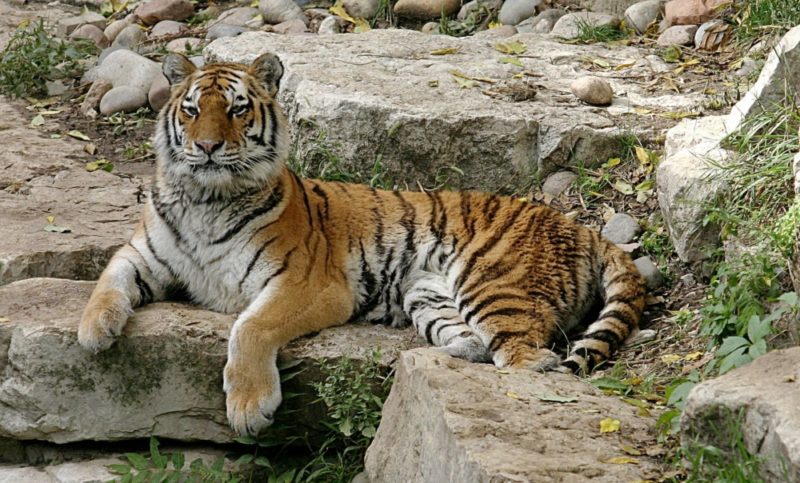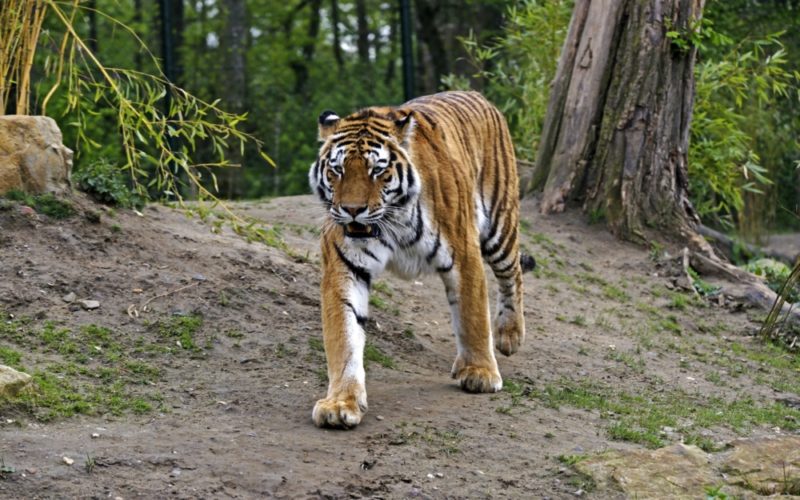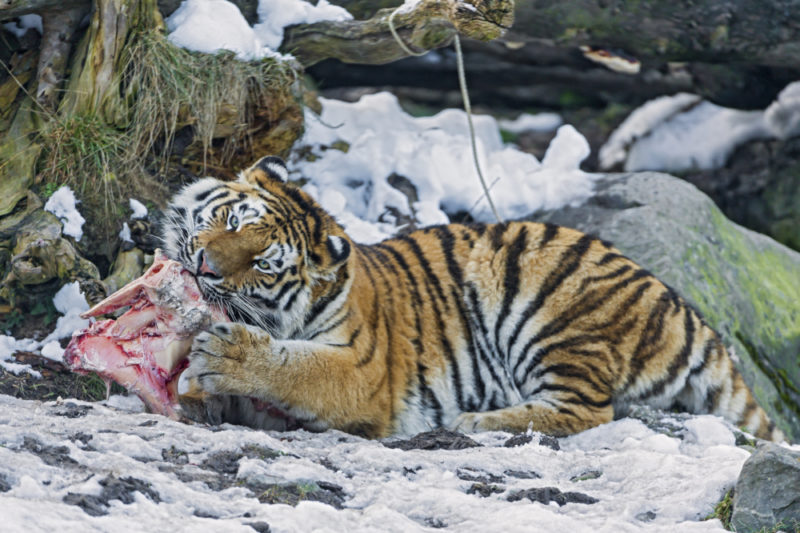Siberian tiger is also called Amur, Ussuri, Far East. This northern representative of the cat family is listed in the Red Book of Russia and the International Union for Conservation of Nature. Evenki call it “amba”, which means “great”, “huge”.
Material Content:
Description of the appearance of the Amur tiger
Subtype Description:
- The predator has an elongated body, which is flexible and covered with thick hair.
- The color of the back is orange, the abdomen is white. The body and round head are covered with bright symmetrical stripes of black color.
- The long and flexible tail is also striped.
- On the head are short ears.
- Able to recognize colors, at night sees better than a person 5 times.
- The length of the animal from the nose to the tip of the tail is 2.7-3.8 m. Females are slightly smaller.
- Weight ranges from 180-306 kg in males, 100-167 kg in females.
Features and habitat
Ussuri taiga - the place where the northernmost tiger lives. This region is known for its extreme climate: in winter it is very cold, in summer it is hot, and it often rains. The terrain is mountainous with diverse vegetation. Most often, cedar and oak floodplain forests are chosen for life. Preference is given to areas where there is a lot of prey. In Russia, its natural habitats are located on the banks of the Amur and Ussuri in close proximity to the Sikhote-Alin ridges.
Adult males live apart. Mark their plots with urine, scratches on trees, loosening of the ground, snow cover. Females take care of the cubs.The hunting grounds of the male are about 1000 square meters. km, female - up to 400 square meters. km
The predator runs fast, swims remarkably, in its youth climbs trees. It can easily cover a distance of 20 km in 24 hours without much work. In this case, it can develop a speed of 18-20 m / s. Able to jump in height at 4-5 meters and 10 meters in length.
Character and lifestyle
The Siberian subspecies eschews a person and does not enter into contact with him. Aggression shows only if injured, or hunters chase him. Hunger makes him attack livestock and dogs. According to statistics, for 10 years, the northernmost cat made 19 attacks on people. Two people died.
He regularly goes around his hunting grounds, and he uses the same paths. Updates tags: scratches the ground and trees with clawed paws, sprinkles urine.
The diet of the Siberian tiger
Predatory animal - feeds on meat. The Siberian tiger hunts a lot, because only 1 out of 10 attempts to provide itself with lunch is successful. Its main food is large ungulates: moose, roe deer, sika deer, wild boars, red deer. Do not shun bear.
If possible, catches fish, frogs, birds, small rodents. Do not give up the fruits of plants and grass. The daily food intake for one large animal is 9-10 kg of meat. For a normal life, a predator needs 50-70 ungulates per year.
Mating season and reproduction of the animal
Reproduction usually occurs in the summer. The female goes to look for the male. If everything goes well, the predators do not part for some time. Many times mate, and with the onset of pregnancy, romantic relationships end, and the male leaves to look for new “adventures”.
The gestation period is approximately 14-16 weeks. Usually in a brood there are three cubs. Cubs are born helpless, blind and deaf. After 14 days, they show vision and hearing. Kids are very playful. Trying to get out of the den and climb the trees. And this over time, they begin to succeed. For the first time they go hunting with a tigress.
Mother feeds them milk for about 6 months. The training of young individuals lasts a long time, and only after two years the family breaks up.
Interesting facts about the predator
Many interesting facts have been collected about the Amur tiger:
- it is the animals of this subspecies that are least of all left on the planet;
- he has the thickest and longest coat;
- he is the largest tiger in the world;
- the longest tail is 110-115 cm;
- it can be attributed to the "absolute predators" - it attacks everyone who is smaller in size;
- for the future does not kill, but only as much as he can eat;
- hunts from an ambush, creeping up to the victim. He eats lying, holding the meat with his paws. The remains of the feast hides;
- less often than other felines attack humans. The cause is unknown;
- they are very silent, cast their voice only during the mating season;
- thick hair and a 5 cm layer of fat on the stomach help the animal to survive in harsh winters;
- the stripes on the body are individual, never repeated, like human fingerprints. Coloring not only on the fur, but also on the skin;
- the tiger is depicted on the coat of arms of the Primorsky Territory;
- China introduced the death penalty for the killing of this predator;
- The image of an animal is used in animation and literature.
Red Book and Amur Tiger
The time has come to take care of maintaining the subspecies. Only about 30% of individuals die due to natural causes. The remaining cases relate to poaching. Their organs are used in traditional Chinese medicine. Their price in illegal markets is prohibitive, so the animals almost completely disappeared.
This animal is protected by the state and is listed in the Red Book. A program has been developed to protect them from poachers, to preserve the food supply and its habitats. In addition, modern technology is used to monitor the population.
In the mid-forties of the last century, the number of tigers was 40 individuals. In 2015, there were 540 of them in nature, plus about 450 held in captivity.
A special reserve "Ussuriysky" was created. Employees support the ungulate population, protect the area from poachers and fires, observe tigers and conduct scientific research.
Measures to protect tigers stopped the total destruction of unique animals. But it’s too early to stop helping. The care and attention of specialists will do their job: our grandchildren and great-grandchildren will be able to see this feline representative live.

















